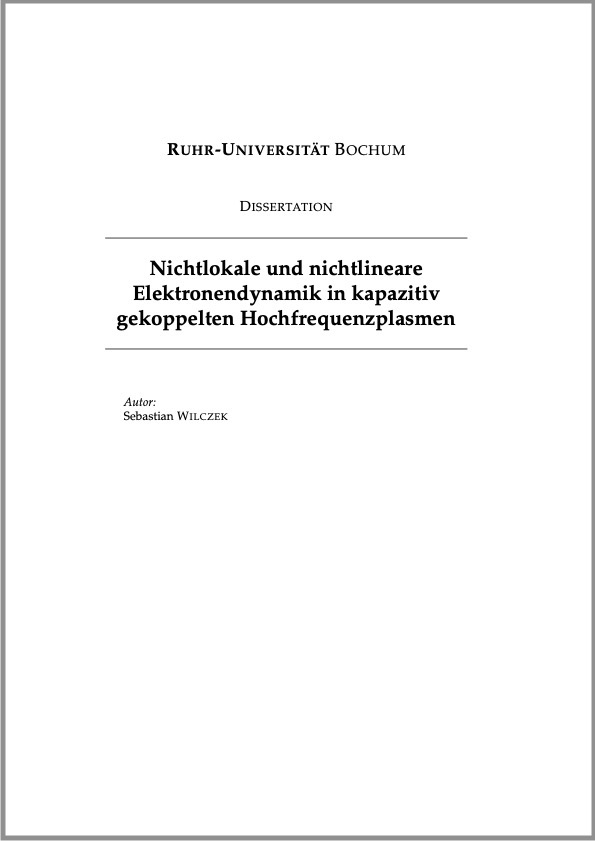Zusammenfassung
Summary

Kapazitiv gekoppelte Hochfrequenzentladungen im Niederdruckbereich bieten eine Vielzahl von technischen Anwendungen, wie beispielsweise das Plasmaätzen in der Halbleitertechnik sowie das Plasmazerstäuben in der Beschichtungstechnologie. Eine essentielle Rolle in diesen Entladungen spielt die Elektronendynamik, welche für den Ionisationsprozess grundlegend ist und somit die resultierende Verteilungsfunktion von Ionen und Radikalen an den Oberflächen (z.B. eines Silizium-Wafers) beeinflusst. Im Druckbereich von weniger als 10 Pascal weisen Elektronen eine mittlere freie Weglänge auf, welche teilweise größer als die Systemlänge (Plattenabstand der Elektroden) ist. In diesem sogenannten ``nichtlokalen'' Regime gewinnen Elektronen ihre Energie im Wesentlichen durch die Expansion der Plasmarandschichten. Dies führt dazu, dass sich die Elektronen gerichtet (als Elektronenbeam) und nahezu stoßfrei durch den Plasmabulk bewegen. Dieser nichtlokale Elektronentransport führt zu einer komplizierten Raum- und Zeitabhängigkeit sowie einer ausgeprägten Anisotropie in der Verteilungsfunktion. Speziell bei kleinen Plattenabständen und geringen Gasdrücken können hochenergetische Elektronenbeams stoßfrei zwischen den beiden Randschichten interagieren, wobei deren Auftreffzeitpunkt mit der Randschichtphase eine entscheidende Rolle spielt. Ist der Auftreffzeitpunkt während der kollabierenden Phase der Randschicht, verlieren die Elektronen effektiv Energie, da sie durch das zeitlich sinkende Randschichtpotential abgebremst werden. Zusätzlich können die hochenergetischen Beamelektronen vor allem zum Zeitpunkt des Randschichtkollaps das Randschichtpotential überwinden und an der Elektrode samt ihrer Energie verloren gehen. Die Einschlussgüte des Elektronenbeams kann mit einer geeigneten Parameterwahl von Anregungsfrequenz, Plattenabstand der Elektroden und Gasdruck eingestellt werden, wobei die Plasmadichte um bis zu zwei Größenordnungen variieren kann. Ein weiterer wichtiger Mechanismus bei niedrigen Drücken ist die ``nichtlineare'' Elektronendynamik, welche experimentell durch hochfrequente Oszillationen im Strom an der Elektrode nachgewiesen werden kann. Durch das Eindringen eines Beams in den Plasmabulk kann eine lokale Modulation des elektrischen Feldes zwischen Randschicht und Bulk entstehen, was zu Plasmaoszillationen und elektrostatischen Wellen führen kann. Darüber hinaus kann die Erzeugung multipler Elektronenbeams während der Randschichtexpansion den Ionisationsprozess maßgeblich verstärken. Diese Arbeit liefert anhand von 1D3V Particle-In-Cell / Monte Carlo Collisions Simulationen einen fundamentalen Einblick in die Elektronendynamik und erläutert im Detail die Auswirkung von nichtlokalen und nichtlinearen Effekten in diesem Regime.
Capacitively coupled radio-frequency discharges in the low-pressure range offer a variety of technical applications, such as plasma etching in semiconductor technology and plasma sputtering in coating technology. An essential role in these discharges is played by electron dynamics, which is fundamental to the ionization process and thus influences the resulting distribution function of ions and radicals at the surfaces (e.g. of a silicon wafer). In the pressure range of less than 10 Pascal, electrons exhibit a mean free path which is sometimes larger than the system length (electrode gap separation). In this so-called ``nonlocal'' regime, electrons gain their energy essentially by expansion of the plasma sheath. This results in electrons moving directionally (as electron beams) and almost collisionlessly through the plasma bulk. This non-local electron transport leads to a complicated space and time dependence as well as a pronounced anisotropy in the distribution function. Especially at small electrode gap separations and low gas pressures, high-energy electron beams can interact collisionlessly between the two boundary sheaths, and their impingement phase with the plasma sheath phase plays a crucial role. If the impact time is during the collapsing phase of the plasma sheath, the electrons effectively lose energy as they are decelerated by the time-decreasing plasma sheath potential. In addition, the high-energy beam electrons can overcome the plasma sheath potential, especially at the time of sheath collapse, and be lost at the electrode including with their energy. The confinement quality of the electron beam can be tuned with an appropriate parameter choice of excitation frequency, electrode gap separation, and gas pressure, and the plasma density can vary by up to two orders of magnitude. Another important mechanism at low pressures is the ``nonlinear'' electron dynamics, which can be detected experimentally by high-frequency oscillations in the current at the electrode. The penetration of a beam into the plasma bulk can cause a local modulation of the electric field between the plasma sheath and the bulk, leading to plasma oscillations and electrostatic waves. Moreover, the generation of multiple electron beams during the sheath expansion can significantly enhance the ionization process. Using 1D3V Particle-In-Cell / Monte Carlo Collisions simulations, this work provides a fundamental insight into electron dynamics and explains in detail the impact of nonlocal and nonlinear effects in this regime.
Inhalt
Content
- Einleitung
- Modellierung kapazitiv gekoppelter Plasmen
- Particle-In-Cell / Monte Carlo Collisions Simulation
- Grundlagen der Elektronendynamik
- Nichtlokale Elektronendynamik
- Nichtlineare Elektronendynamik
- Zusammenfassung und Ausblick
- Introduction
- Modeling of capacitively coupled plasmas
- Particle-In-Cell / Monte Carlo Collisions Simulation
- Fundamentals of electron dynamics
- Nonlocal electron dynamics
- Nonlinear electron dynamics
- Summary and outlook
